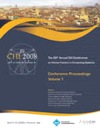CHI 2008: a selection on product design
(Papers are linked to their pdf downloads, if available.)
Case study: using online communities to drive commercial product development [abstract]
Authors: Sheena Lewis (IBM)
Abstract: This paper demonstrates how human computer interaction (HCI) practitioners utilize an online community to drive commercial product innovation, definition, and development. Upper management’s increased interest in user feedback suggests that this development strategy promotes the case for stronger human-centered design processes to be included in corporate strategic planning.
Future Craft: how digital media is transforming product design [abstract]
Authors: Leonardo Bonanni, Amanda Parkes, Hiroshi Ishii (MIT Media Lab)
Abstract: The open and collective traditions of the interaction community have created new opportunities for product designers to engage in the social issues around industrial production. This paper introduces Future Craft, a design methodology which applies emerging digital tools and processes to product design toward new objects that are socially and environmentally sustainable. We present the results of teaching the Future Craft curriculum at the MIT Media Lab including principal themes of public, local and personal design, resources, assignments and student work. Novel ethnographic methods are discussed with relevance to informing the design of physical products. We aim to create a dialogue around these themes for the product design and HCI communities.
“If you build it, they will come … if they can”: pitfalls of releasing the same product globally [abstract]
Authors: Ann Hsieh, Todd Hausman, Nerija Titus and Jennifer Miller (Yahoo, Inc.)
Abstract: As companies based in the US launch more interactive, “Web 2.0â€-style products, the rest of the world may not be moving at the same speed. This presentation will reveal the pitfalls of building the same product for all audiences across many countries, especially when it comes to economic, technological, and cultural disparities. This illustrates the point that even if global users want to access new products, they may not always have the means.
What about a ‘local’ wrapper around an ‘universal’ core? [abstract]
Authors: Apala Lahiri Chavan (Human Factors International)
Abstract: In this paper, I examine the possibility of restructuring our premise about cross cultural design and explore a possible new way to look at how we can create products in one culture and yet have the whole ‘flat world’ use it!
Studying paper use to inform the design of personal and portable technology [abstract]
Authors: Daniela Rosner, Lora Oehlberg and Kimiko Ryokai (UC Berkeley)
Abstract: This paper introduces design guidelines for new technology that leverage our understanding of traditional interactions with bound paper in the form of books and notebooks. Existing, physical interactions with books have evolved over hundreds of years, providing a rich history that we can use to inform our design of new computing technologies. In this paper, we initially survey existing paper technology and summarize previous historical and anthropological analyses of people’s interactions with bound paper. We then present our development of three design principles for personal and portable technologies based on these analyses. For each design guideline, we describe a design scenario illustrating these principles in action.




